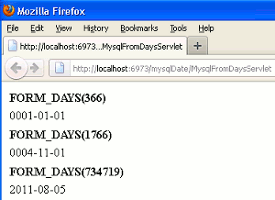In this tutorial you will learn about how to use mysql from_days() function in java servlet.
Mysql FROM_DAYS() Function Example using Java Servlet
In this tutorial you will learn about how to use mysql from_days() function in java servlet.
FROM_DAYS() function gives back a date by taking a datevalue (as a number) in its parameter as argument or returns the date as 0000-00-00 or throws SQLException.
Syntax :
from_days(n);
Here the argument 'n' is a datevalue (as a number).
Now, since I have to use this function in java servlet program, therefore I have created a java servlet class named MysqlFromDaysServlet which extends the HttpServlet class. In the body of class I overridden the method doGet() and created an objects of HttpServletRequest and HttpServletResponse into its parameter. Inside the doGet() method first I set the mime type that in which format the browser will show the output. In the next line I used the getWriter() method of ServletResponse interface with the object of HttpServletResponse. HttpServletResponse interface extends this method from the ServletResponse. In continue we have to make a connection between java code and database system. So, since I am using Mysql in the example given below therefore, I am loading the driver of mysql and make a connection by using the getConnection() method of DriverManager class. It returns a Connection. Further I am passing the query "SELECT FROM_DAYS(366)" (This query will return the date (0001-01-01), different parameter will give different result) with different parameters into the parameter of prepareStatement() method of Connection interface which gives an object of PreparedStatement interface. In the next line I used the executeQuery() method of PreparedStatement interface which returns a ResultSet object that holds the result of query. At last I have extracted the result from the ResultSet object.
Example :
MysqlFromDaysServlet.java
import java.io.IOException;
import java.io.PrintWriter;
import java.sql.SQLException;
import java.sql.DriverManager;
import java.sql.Connection;
import java.sql.ResultSet;
import java.sql.PreparedStatement;
import javax.servlet.ServletException;
import javax.servlet.http.HttpServlet;
import javax.servlet.http.HttpServletRequest;
import javax.servlet.http.HttpServletResponse;
public class MysqlFromDaysServlet extends HttpServlet
{
public void doGet(HttpServletRequest req, HttpServletResponse res)
throws IOException, ServletException
{
res.setContentType("text/html");
PrintWriter pw = res.getWriter();
String className = "com.mysql.jdbc.Driver";
String url = "jdbc:mysql://192.168.10.13/data";
String user = "root";
String password = "root";
String sql = "SELECT FROM_DAYS(366)";
String sql1 = "SELECT FROM_DAYS(1766)";
String sql2 = "SELECT FROM_DAYS(734719)";
Connection con;
PreparedStatement ps;
ResultSet rs, rs1, rs2;
try
{
Class.forName(className);
con = DriverManager.getConnection(url, user, password);
ps = con.prepareStatement(sql);
rs = ps.executeQuery();
pw.println("<table><tr>");
pw.println("<td><b>FORM_DAYS(366)</b></td>");
pw.println("</tr>");
while(rs.next())
{
String days = rs.getString(1);
pw.println("<tr>");
pw.println("<td>"+days+"</td>");
pw.println("</tr>");
}
pw.println("</table>");
pw.println("<table><tr>");
pw.println("<td><b>FORM_DAYS(1766)</b></td>");
pw.println("</tr>");
ps = con.prepareStatement(sql1);
rs1 = ps.executeQuery();
while(rs1.next())
{
String days = rs1.getString(1);
pw.println("<tr>");
pw.println("<td>"+days+"</td>");
pw.println("</tr>");
}
ps = con.prepareStatement(sql2);
rs2 = ps.executeQuery();
pw.println("</table>");
pw.println("<table><tr>");
pw.println("<td><b>FORM_DAYS(734719)</b></td>");
pw.println("</tr>");
ps = con.prepareStatement(sql1);
rs1 = ps.executeQuery();
while(rs2.next())
{
String days = rs2.getString(1);
pw.println("<tr>");
pw.println("<td>"+days+"</td>");
pw.println("</tr>");
}
pw.println("</table>");
}
catch(SQLException sx)
{
pw.println(sx);
}
catch(ClassNotFoundException cx)
{
pw.println(cx);
}
}
}
web.xml
<?xml version="1.0" encoding="UTF-8"?> <web-app id="WebApp_ID" version="2.4" xmlns="http://java.sun.com/xml/ns/j2ee" xmlns:xsi="http://www.w3.org/2001/XMLSchema-instance" xsi:schemaLocation="http://java.sun.com/xml/ns/j2ee http://java.sun.com/xml/ns/j2ee/web-app_2_4.xsd"> <display-name>mysqlDate</display-name> <servlet> <servlet-name>MysqlFromDaysServlet</servlet-name> <servlet-class>MysqlFromDaysServlet</servlet-class> </servlet> <servlet-mapping> <servlet-name>MysqlFromDaysServlet</servlet-name> <url-pattern>/MysqlFromDaysServlet</url-pattern> </servlet-mapping> </web-app>
Output :
When you will execute the above example you will get the output as :



[ 0 ] Comments